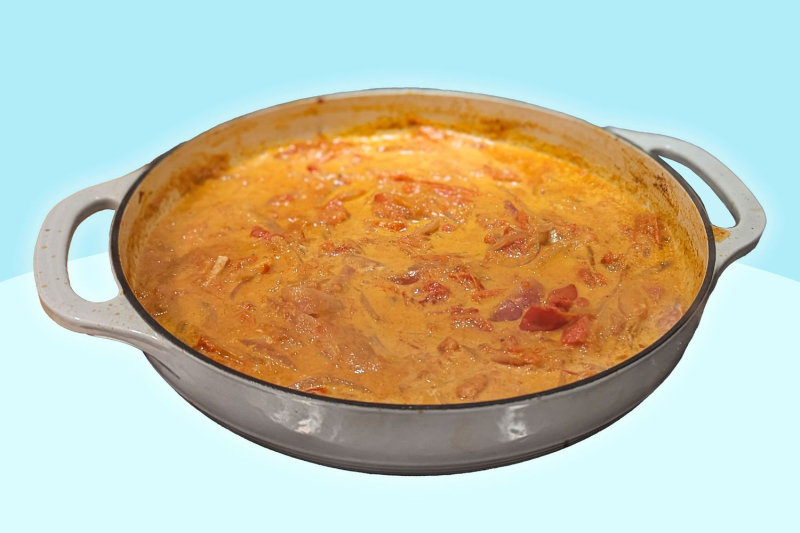A few souper easy tricks make for the most luscious, flavorful tomato soup I've ever eaten.
When everyone—even an avowed tomato hater—excitedly gobbles up big bowls of tomato soup, you know you have a winner on your hands. That's exactly what happened when I recently made Gordon Ramsay's creamy tomato soup for my book club. One friend texted me a couple of days later to say, "Craving that tomato soup!" and everyone's been asking for the recipe.
The soup, which Ramsay demonstrates in this YouTube video, has just a handful of ingredients and is incredibly easy to make. But although the soup is simple, Ramsay has several tricks that really take this creamy, ultra-flavorful soup to the next level—and the great news is that you can use his tips to improve any tomato soup recipe. Here’s a breakdown of what I learned about making the best creamy tomato soup by watching Ramsay.
What You Need You to Make Gordon Ramsay's Tomato Soup
The first step to making Ramsay's soup is gathering the ingredients. Ramsay uses fresh tomatoes for the recipe and says, "the riper the better" for the best flavor. You could even use slightly overripe tomatoes for this recipe. While I used end-of-season heirloom tomatoes for my soup, with all of Ramsay's flavor boosting tricks this soup would still be delicious with the types of tomatoes you can get at the grocery store year-round, such as Romas or tomatoes on the vine.
Beyond the tomatoes, the soup gets a lot of flavor from sliced garlic and onion—Ramsay chooses red onion because he says it's sweeter than white onion. It also adds a pretty pop of color to the soup. Ramsay doesn't give amounts in his demonstration but here's where I landed after watching the video numerous times and it turned out great—it's a very forgiving recipe so don't worry too much about the exact proportions.
Gather Your Ingredients
- 3 1/2 pounds small or medium tomatoes, cored, and halved
- 1 large or 2 medium red onions, sliced
- 2 cloves garlic, sliced
- 2 tablespoons olive oil (or more as needed)
- Salt and pepper to taste
- 1/8 to 1 teaspoon cayenne
- 1 teaspoon sugar
- 1 tablespoon balsamic vinegar (or to taste)
- 1-2 cups vegetable stock or chicken stock
- 1/2 cup heavy cream
Start On the Stovetop
The first trick Ramsay has up his sleeve is searing the tomatoes, onions, and garlic on the stovetop. He explains that searing the ingredients on the stovetop before putting the pan into the oven helps the tomatoes roast instead of stew, giving the soup a more concentrated, sweet flavor. Choose an oven-safe pan large enough to spread all of the ingredients out so there's dry air circulating around them both on the stovetop and in the oven.
Ramsay heats the roasting pan over two burners on the stovetop and adds a generous amount of olive oil—using plenty of olive oil makes the soup glossy, he explains, and it also gives it a richer flavor and fuller body. Then he tosses the sliced garlic and onions into the pan and spreads them out so they are all in contact with the surface of the pan.
As the onions and garlic sizzle away, he adds salt and pepper, and then sprinkles on a teaspoon of cayenne pepper. The cayenne gives the soup a nice warmth, he explains. The spicy kick plays well with the sweetness of the other ingredients, but I recommend using 1/8 to 1/4 teaspoon the first time you make the soup. It was just on the edge of too spicy for some of my friends with the full teaspoon, and you can always add more before serving.
Next up come the tomatoes, which Ramsay nestles in the pan flesh-side-down, allowing them to caramelize nicely. Spread the tomatoes out so each one is fully in contact with the bottom of the pan.
As everything continues to sizzle, he sprinkles the tomatoes with a teaspoon of sugar, which he says helps intensify the sweetness of the soup. It also helps with the caramelization of the tomatoes and onions. After adding the sugar, he glugs on some aged balsamic vinegar, which, as he says, "gives that nice dark, rich acidity to the soup." I used about a tablespoon, but you could use more or less, to taste.
Then Move It To the Oven
At this point, Ramsay transfers the pan to the oven for 20 to 25 minutes. He has his oven set to 180 celsius, which is 356 fahrenheit, but I went ahead and cranked mine up to 400 F, my preferred temperature for roasting vegetables.
When the tomatoes and onions are fragrant, tender, and slightly browned, he pulls the pan out of the oven and transfers it back to the stovetop. (Despite using a higher oven temperature than Ramsay, I kept my tomato mixture in the oven for 25 minutes and that was the perfect amount of time.) He turns on the burners, then adds vegetable stock or chicken stock until it "sits halfway up the tomatoes." I needed about a cup and a half of stock and I used veggie stock to keep the soup vegetarian.
Finish It With Cream
He brings the mixture up to a boil and lets it simmer for 3 or 4 minutes, stirring and breaking the tomatoes apart with a wooden spoon. Then he adds cream—I used a half cup of heavy cream, which was just the right amount to make the soup rich tasting without overwhelming the flavor of the tomato and onions. While Ramsay doesn't say to do this, I lowered the temperature when I added the cream to stop the soup from boiling.
Use a Potato Masher for a Soup With More Texture
Once the cream is incorporated, Ramsay uses a potato masher to break up the tomatoes for a rustic soup. He notes that you can also use an immersion blender if you prefer a smoother soup. I like my soup to have a bit of texture, so I simply used a wooden spoon to break up the tomatoes. Whether you go for the more rustic version or the creamy version, be sure to follow Ramsay's tip of scraping any caramelized bits up from the bottom of the pan and stirring them in to permeate the soup with "amazing flavor."
Ramsay serves his soup topped with sundried tomato pesto, which is a nice touch but definitely not essential—this soup has plenty of flavor without it. He serves Welsh rarebit on the side, while I served mine with some Georgian cheese bread I picked up at the same farmstand as the tomatoes. But this soup is so rich in flavor and satisfying, it really doesn’t need anything more than some crusty bread to sop up every last bite.


